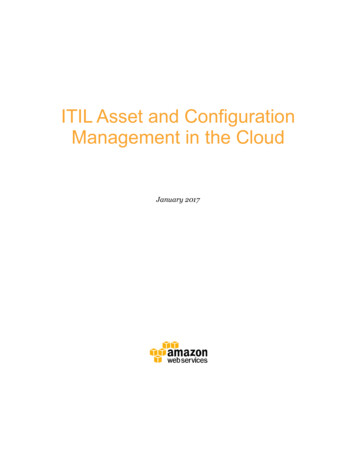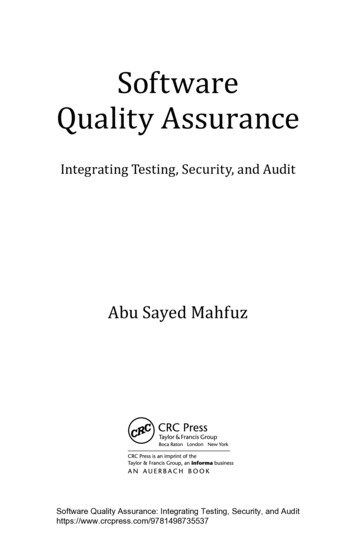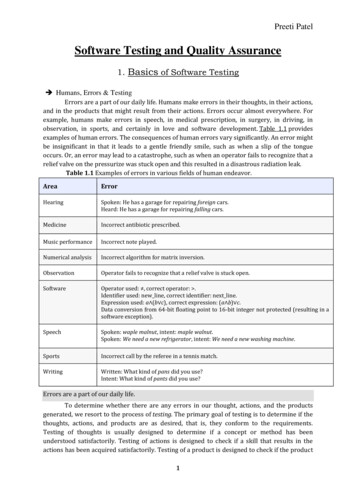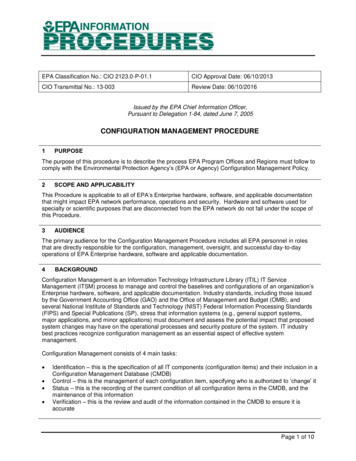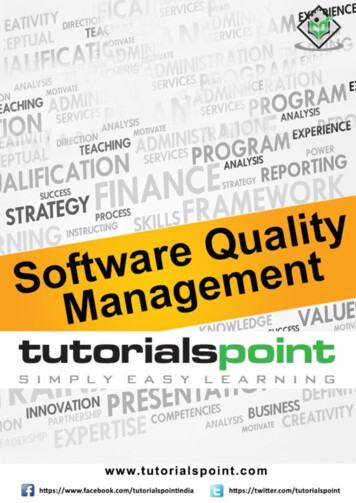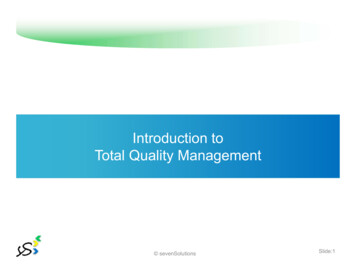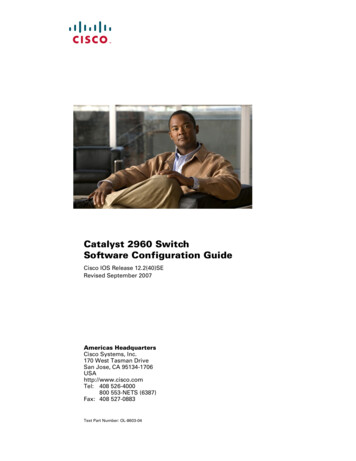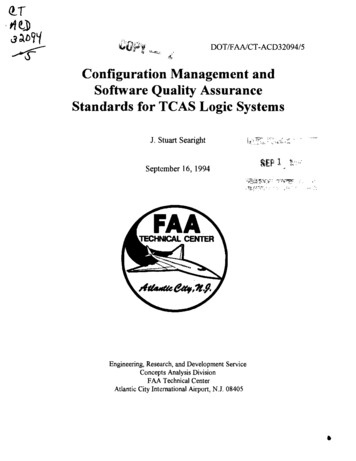
Transcription
DOTIFANCT-ACD32094/5Configuration Management andSoftware Quality AssuranceStandards for TCAS Logic SystemsJ. Stuart SearightSeptember 16, 1994jF'\()::,. 'f1:,e: "':, ,'; I?:!; l "T "\;' -c;Engineering, Research, and Development ServiceConcepts Analysis DivisionFAA Technical CenterAtlantic City International Airport, N.J. 08405
EXECUTIVE SUMMARYThis document describes the Software Configuration Management (SCM) and Quality Assurance (QA)standards and procedures used for all software maintained by Traffic Alert and Collision AvoidanceSystem (TCAS) Logic Systems personnel at the FAA Technical Center. These standards and procedureswill ensure that integrity is maintained throughout the life-cycle of all TCAS software, and provide a welldefined course of action to implement changes to the baseline software.
1.0 PURPOSE AND SCOPE OF THIS DOCUMENTThis document describes the Software Configuration Management (SCM) and Quality Assurance (QA)standards and procedures to be used for all software maintained by Traffic Alert and Collision AvoidanceSystem (TCAS) Logic Systems personnel at the FAA Technical Center. It details the steps required tomake a change to the baseline software. These steps include the procedures for documenting the need ordesire for a change to the baseline software; evaluating the request for change; assigning of the duty ofmaking a change; changing of the baseline software; testing of the software change for accuracy,completeness, and proper integration with the existing baseline software; and admitting the changedsoftware to the baseline.2.0 BACKGROUNDThe FAA Technical Center TCAS Logic Systems personnel have developed software tools to assist inevaluation of proposed/revised TCAS Illogic version releases, and recorded flight data from the TCASTransition Program (TTP). This library of baseline software is currently stored on a Local Area Network(LAN) file server that connects all TCAS personal computers (PCs) on a Novell Netware 3.21 platform.The source code is currently in Borland Turbo Pascal 7.0, which is currently run in the MS DOS5.0fWindows 3.1 environment. For a detailed description of the Turbo Pascal environmen refer tosection 5. I ofthis report.To ensure baseline integrity and effectively mortitor software development efforts, SCM and QA standardsand procedures must be adhered to. This document describes those standards in a formal and detailedmanner.2.1 SOFlWARE DESCRIPTIONThere are two main software systems and support programs in the TCAS baseline. The first is the FAATechnical Center's Fast Time Encounter Generator (FTEG), with its support routines and post-processingprograms. This software simulates TCAS urtits operating in predefined aircraft encounter geometries. Itcan implement a variety of TCAS Logic versions and can simulate thousands of aircraft encountergeometries in a short period of time. The second system is TCAS Data Reduction and Analysis (DRNA).This software analyzes data recorded from both the FTEG and actual TCAS units. There are currentlyfive manufacturers of TCAS I and TCAS 11 units. The data from TCAS units is called "live" data. TheDRNA processing of live data forms the hasis of the FAA Technical Center's evaluation of TCASperformance which is part of the TCAS Transition Program (TTP). While some software is common toall live data, much is specific to the various manufacture's recording formals and cycle timing.The baseline is categorized into groups in two different ways. The first is a physical grouping into twocategories labeled PROGS and UNITS. These labels correspond to two directories on the LAN file serverwhich contain the entire software baseline of the Logic Systems project. PROGS contains all source codefiles that contain Pascal programs. All support routines are found within the UNITS directory. Each ismapped to a logical drive on the file server. While everyone has read permission to these directories, onlythe Configuration Manager (CM) and Technical Program Manager (TPM) have write permissions.The second grouping is into logical groups, with the baseline broken down into a variety of subsystems.These are more detailed divisions within the FTEG and DRNA partitions. These groupings includeTCAS logic versions. FTEG and other drivers for the logic, FTEG post-processing, encounter summaryprintouts, TTP processing, recorded encounter data processing, recorded track data processing, andcommon support routines shared by various subsystems. These subsystems have been assigned among theFAA staff. The FAA employee is considered the Technical Lead (TL) of his or her assigned subsystems.
Familiarity of source code, code usage, and output evaluation were considerations in the current TLsubsystem assignments. The TL will playa vital role in software development and maintenance.The TLs and the TPM meet weekly as a confib'Uration management control board (CMCB). In thesemeetings submitted Problemrrrouble Reports (PTRs), assigned work, and completed baseline updates areall discussed. Project short- and mid-range priorities and plans are developed as the different individualsubsystem priorities and issues are merged together. The support contractors join the CMCB every otherweek after the CMCB meeting to provide status updates on assigned work, and to exchange feedback onwork loads, priorities, etc.3.0 CONFIGURATION MANAGEMENTThis section defines the procedures necessary to make an update to the baseline. It covers the entireprocess including problem identification, design, coding, and testing.3.1 PROBLEM DETECTION and CHANGE REQUESTSAny TCAS personnel can submit a Problemrrrouble Report form to the Configuration Manager at anytime. (This form is shown in Page I of Appendix A) These forms serve as either Change Requests orProblem Reports. Change Requests are usually used to suggest improvements to the software systems inareas such as user interface, output formats, documentation, and performance efficiency. ProblemReports deal with errors such as faulty output, incorrect internal processing, inadequate algorithms,system crashes, and incorrect error handling. When a Problem Report is submitted, the data set thatcaused the problem to be noticed must be cited.PTRs should be written with respect to the requirements of the system that contains the respectiveproblem, error, or deficiency. If a requirements specification document exists for the system, the PTRshould reference the requirement being met. If the system does not have a requirements specificationwritten for it, the author of the PTR should identify the quantifiable and testable requirement(s) of thesystem that are not being met and write the PTR in reference to that requirement.The Configuration Manager will examine the PTR for completeness and accuracy. Once the PTR isaccepted, it will be numbered, and entered into the PTR database. The TL of the identified subsystem willthen evaluate the PTR's priority and, at an appropriate time, assign the PTR to an FAA staff member or asupport contractor. This person will be referred to as the programmer throughout the softwaredevelopment process. The TL will coordinate with the assigned programmers regarding their workperformed to resolve the PTRs assigned from the TL's particular subsystems.3.2 UPDATING and UPGRADING OF BASELINE SOFTWAREThis section defines the processes necessary, and the individuals responsible for addressing identifieddeficiencies in the baseline, updating applicable source code, and readmitting that code back into thebaseline.3.2.1 PROCESS OF MAKING UPDATES TO BASELINEThis section lists the steps to create or modify code as dictated by one or more PTRs.I) The programmer will study the assigned PTR and all applicable code.2) The programmer will formulate design and implementation considerations for the work needed andwrite documentation stating these design and implementation plans. These documents will be reviewedby the Technical Lead. The process does not continue until the following are agreed upon by both2
programmer and 11.: design and implementation documentation is developed that specifies a design thatwill meet all requirements of the assigned PTR; all documentation that will need revision to reflect thesoftware update are identified; the level of testing to be performed after coding is complete is specified.3) The programmer will sign out all files from the Configuration Manager that will undergo changes toresolve the PTR. The SIGN OUT list is a Word 2.0 file found on the NEW logical LAN drive. All LogicSystems team members, including contractors. have read/write access to this file. The process of signingout files involves updating this file with the following information: adding the programmer's name, thefile(s) being signed out, the date and size of the baseline version of the filers), the date signed out, and thePTR being addressed. A file should only be signed out by one person at one time to prevent simultaneousupdates to the baseline.4) The programmer will copy the code from tbe LAN's baseline directories to the proper directory localto the programmer's Pc. Each TCAS Logic Systems PC has directories that mirror the baseline, andstandard compile directories that correspond to this directory structure. (These are specified in section5.1.)5) The programmer will edit or create the code to meet the requirements specified in the PTR andagreed upon in step 2. This includes adhering to all documentation standards described in section 4.6) The programmer will test the new code to satisfY the 11. and as outlined in section 3.3.7) Any deficiencies found through the testing phase shall be corrected and the codc retested until nodeficiencies exist.8) Upon successful completion of the testing procedures, the programmer will complete a CHANGEFORM (CF) that thoroughly describes the changers) that have been made to new or baseline software (seePage 2 Appendix A).9) The programmer will copy the unites) and/or program(s) into the LAN's NEW directory to awaitreadmittance to the baseline. NEW's subdirectories mirror the baseline directories (PROGS and UNITS).All TCAS personnel have write permission to the NEW subdirectories. The extension of the unit's file isto be the initials of the programmer responsible for the changes. This safeguards against duplicateupdates not prevented by the SIGN-oUT sheet.10) The Technical Lead will review the programmer's submitted code, documentation and test results.The set of submitted files will include updated or new source code, output files from performedtesting, and output files from the file compare DOS utility of updated files vs. the baseline files. Thesubmitted source code will be copied into the appropriate NEW subdirectory (UNITS or PROGS) with theextension being the programmer's initials. The test output files will retain their original extensions and becopied into the TESTING subdirectory of NEW. File compare outputs will have an extension of'FC', andbe copied into the same subdirectory as the corresponding source code.Documentation will include completed CF(s), updated reference documents, when applicable, and awritten summary of performed testing. This summary will included what files were tested, a descriptionof each test's purpose, and its result. The 11. will examine all submitted materials and reference theoriginal PTR and the design and implementation documents previously agreed to by the 11. andprogrammer.II) The 11. can request the programmer, or perform themselves, any extra testing deemed necessary.12) If the 11. is satisfied with the update, the CF is filed with the Configuration Manager.3
13) The Configuration Manager will review the submitted CF(s) and examine completed review processwith TL.14) The Configuration Manager will check all updated files for CM integrity. This includes checkingthat all previous updates are still in submitted tile, date of file matches date of most recent comments, etc.15) The Configuration Manager will initiate or perform any extra testing deemed necessary.16) If all previous steps have been satisfied, the updated or new code is written into the baseline with aPAS extension.3.2.2 CREATING NEW CODE FOR THE BASELINEIf a new program or support unit has been created by TCAS personnel, it must be put into the properNEW subdirectory on the LAN. First, a PTR must be written and accepted stating the need for the newcode, and describing the new code's requirements. The new code is to be accompanied by a CHANGEFORM that is sent to the Technical Lead. This CHANGE FORM should describe the new code's purpose,its output, and any interface it has with existing baseline software. The new code must go through thereview and testing procedures defined in section 3.3 of this document. Upon successful testing it willawait admittance to the baseline.3.3 INDIVIDUAL'S RESPONSmILITIESThe above sections described the process of identiJ'ying deficiencies within the baseline, and updatingsource code to bring the issue to closure. This section also addresses these activities, but from a differentpoint of view. The sections below are divided by individuals, and their responsibilities in seeing a PTRbrought to closure. There are four sections. One each for the programmer, Technical Lead,Configuration Manager, and Technical Program Manager. For all software updates there are threepositions whose roles must be performed: Programmer - completes design, actual updates to baseline code,and testing; Technical Lead - reviews design, code changes and testing; Configuration Manager - acceptsthe change and updates baseline.It should also be noted that the Technical Leads can function as programmer, the Configuration Manageris also a Technical Lead, and the TPM can function as any of the other three roles. No one person is toact in two different capacities for anyone piece of work that leads to an update to the baseline. If, forexample, a TL assigns himselfJherself as progranuner to close out a PTR, they must first solicit anotherperson to act as TL for the work being done. When a change is being done for a subsystem of which theCM is TL, the TPM must act as CM for those efforts.3.3.1 PROGRAMMERI) Develops thorough design and implementation documentation addressing the assigned problem.2) Signs out source code after design is approved.3) Reviews progress and coordinate with TL during and after each step of software development process.4) Thoroughly tests work before submitting it to TL for final inspection.3.3.2 TECHNICAL LEADI) Review new PTRs for the following:a) is a duplicate, or similar PTR already in the database?b) level of urgencyc) magnitude of the changed) impact on other subsystems4
e) changes to recorded record structuresf) changes needed to support documentation2) Assign PTR to a programmer.3) Review programmer's initial design:a) Will the design fix the identified problem?b) Will the design have any effects on other subsystems?c) Will the design change the format of any recorded record structures'!d) Does the design conform to defined software standards?4) Review the programmer's implementation:a) Are all changes commented in source code'!b) Examine all changes (use file compare utility).c) The cited problem is fixed. (New code appears to address problem.)5) Review programmer's testing coverage and results.a) Was all necessary testing completcd'!b) Were there test cases that addressed all concerns?c) Are results as expected?d) Are there any side-effects to other subsystems'! Is this acceptable with the TL(s) of thosesubsystems?e) Has all needed documents been updated?6) Review Change Form(s) submitted with updated code.a) Are all required fields filled in?b) Does the CF clearly describe the change(s) made?3.3.3 CONFIGURATION MANAGERI) Perform initial review of all submitted PTRs.a) Are all required fields filled in'!b) Is proper subsystem identified'!c) [s priority appropriate for scope of problem cited'!d) [s problem clearly stated?2) Number accepted PTR.3) Forward PTR to appropriate TL.4) Review submitted code, testing, and documentation after TL has accepted update.a) Does date at top offile reflect last change?b) Does file contain all previously accepted changes?c) Are comment blocks properly updated'!d) Are updated lines of code properly commented?e) Does CF reference correct PTR'!f) Was level of programmer's testing and TL's review appropriate for the change's magnitude.g) Were all necessary updates to documents completed?6) Enter CF into database.7) Update PTR database to have cited PTR reference CF.8) Update baseline with accepted source code and document changes.9) Update SIGN OUT list to reflect files being signed back in.3.3.4 TECHNICAL PROGRAM MANAGERI) Monitor overall software development and testing processes.2) Evaluate if the defined processes are:a) being adhered tob) effective means of ensuring baseline code reliability3) Act as CM or TL when needed. (!fa TL has acted as programmer, the TPM might act as TL. !ftheCM has acted as programmer or TL, the TPM must fill role of CM.)5
3.4 BASELINE SUPPORT DOCUMENTATIONThis section describes the support documentation for the baseline programs and major subsystems. It alsodefines the manner in which these documents fall under the configuration management rules andprocedures defined in sections 3.2 and 3.3.3.4.1 DOCUMENTATION DESCRlPTIONAll documents will be stored as part of the TCAS Baseline in a directory named DOC. (This is asubdirectory ofTCAS just as UNITS and PROGS are.) There will be user documents for all baselineprograms, or groups of similar programs. (For the rest of section 3.6, 'programs' will be equal to thephrase 'programs, or groups of similar programs'.) There will be output definition files for all programsthat define all fields of the generated output file. There will be desigu documents for all major subsystemsof the TCAS baseline. The three sections below describe these documents in greater detail.3.4.1.1 USER DOCUMENTSA user document will be written for all programs. These documents will be named the same as theprogram it describes, or that part of the programs' name that is common to all programs. (i.e. SUM for adocument describing the use of BX SUM, HW SUM, and RC SUM.) The extension will be 'USE'.These documents will describe all user/program interface, available options, default options, and defineneeded input files - any restrictions on their location (drives, subdirectories), and their format - and theavailable destinations of output.3.4.1.2 OUTPUT DEFINITION DOCUMENTSA definition document will be written for all output files that can be generated by baseline programs.These documents will be named the same as the program's name, or major subsystem from which the fileis generated. (i.e. SUMMARY, LISTER, ERD CNTS) The extension will be the same as the output filewhich the document defines. These documents will describe each field in the output file, its origins,expected range, units, and display format if text, or storage format if binary.3.4.1.3 SUBSYSTEM DESIGN DOCUMENTSA desigu document will be written for all major subsystems of the baseline. These documents will benamed to describe the subsystem as best possible. (i.e. SUMMARY, PRM for pilot response model) Theextension will be 'DSN'. These documents will describe subsystem designs and implementations. Thiswill include interfaces to programs and other subsystems, data structures filled in or processed, outputsgenerated, and algorithms implemented.3.4.2 CONFIGURATION MANAGEMENT OF DOCUMENTSThis section describes the manner in which the documents described in section 3.6.1 fall under the TCASCM practices and standards. As with the UNITS and PROGS directories, the DOC directory is asubdirectory of TCAS, and only the CM and TPM have write permission to that directory. There is also aDOC subdirectory of NEW that all programmers have write permission to. It is this directory that updatesare written into, and are promoted to the baseline directory by the CM or TPM.The originator of a PTR, and the assigned programmer should always be examining if the work they aredoing dictates that any document(s) will need updating as a result of the pending baseline update. It is theTL's responsibility to ensure that all submitted updates include updates to the corresponding document(s).6
This is included in the TL's responsibilities defined in section 3.3.2. The Configuration Manager alsomust examine if any submitted updates requirc updates to support documentation (section 3.3.3)3.5 SOFTWARE TESTING STANDARDS and PROCEDURESThis section describes the routines followed when developing and testing new or updated software. Thereare two philosophies utilized to assist in the dcvelopment of correct, robust, and reliable software. Thesephilosophies are used during design and development to assist the programmer, and after the code hasbeen written or updated to test the programmer's work. Preventive measures, used during the designreview, are taken during software development. These practices are in place to help ensure that workrequirements are thoroughly defined and solutions are logically designed. Corrective measures, usedduring implementation verification, are taken after code is updated or written. Testing is done in an effortto find faults in design or implementation. These procedures are defined below.3.5.1 DESIGN REVIEWI) After a programmer has been assigned a PTR and investigated the problem, he/she will develop adesign document as a proposal to bring the PTR to closure. This document will be reviewed by thesubsystem Technical Lead.2) After the design has been agreed upon, the assigned programmer will submit documentation definingproposed implementation plans to the subsystem Technical Lead.3) Actual coding will not begin until both documents have been reviewed and approved by the TechnicalLead.3.5.2 IMPLEMENTATION VERIFICATIONI) A code inspection is performed. The author of the new or changed code will inspect the code forlogical accuracy, clarity, and adherence to format, naming and documentation conventions of the TCASProject. The Technical Lead will also inspect the completed code after it has been suhmitted by theprogrammer.2) The code is to be compiled with the baseline units on the LAN. This will be in the form of a BUILDto assure the new units compile with all other units and programs in the baseline.3) The code is to be tested thoroughly to show that the program execution - A) Reflects the changesthe PTR requested. This is done by processing the Problem Data Set(s) data cited in the PTR and showingthat the faulty output, system crash, or improper error handling has been corrected.B) Does not cause other changes or side-effects that are not desired. This is done by running allprogram drivers that implement the unit(s) that have been created or modified against Standard Data Sets(SDS) that were selected by the programmer BEFORE starting work on the source code. The programmerwill run all applicable programs against the SDSs before code is changed and compare the results with theoutput from the updated code.All test results must be kept for the Technical Lead to inspect. Documentation discussing all testingperformed, the purpose of each test, and the results must also be presented to the TL. The Technical Leadalso will review the updated code, and the submitted Change Form. If everything is found to beacceptable, the CF is forwarded to the Configuration Manager for hislher final inspection.As coding changes are made, the TL should ask for, or locate sufficient test cases for the change beingmade.7
3.6 ADMITTANCE TO THE BASELINEUpon receiving a CHANGE FORM from a programmer, along with the respective test results, theTechnical Lead will then inspect the test results and do any additional testing he/she feels is necessary.The Configuration Manager, after hislher own review, will then copy the new file(s) back into the baselinewith the proper .PAS extension, or hand it back to the programmer with any problems found in the code.(For more detailed description of the review process, refer to section 3.2 of this document.) If the file(s)are put back into the baseline, they will be removed from the SIGN OUT sheet by the ConfigurationManager. The Configuration Manager will then cross-reference the PTR that precipitated the change tothe CHANGE FORM. This ensures the traceability of how PTRs were closed out, and why changes to thebaseline were made.3.7 DELETING CODE FROM BASELINEPTRs can be subntitted requesting routines be deleted from the baseline if routines or entire units areidentified as dead code, or if it is to be replaced by new code tbat will perform the same tasks in animproved manner. The PTR must justiJY the reasons for the routine's or file's deletion. The programmermust also assure the Technical Lead that this deletion will not bave any undesired effects on the rest of thebaseline. The PTR's closure must go through the same procedures and reviews as other PTRs. (For moredetailed description of those procedures, refer to section 3.2 of this document.)3.8 BASELINE ARCHIVESThe Configuration Manager will archive the entire source code baseline once a month. Archives will alsobe saved immediately before any major data collection efforts performed by the Logic Systems team. Themonthly archive will include all intermediate versions of files that bave been updated more than once inthe past month. This ensures that any previous state of the baseline can be recreated. The data collectionarchives will include the entire baseline's source code, the executable code used for collecting the data, allinput files used, and all output files generated.3.9 OFF-SITE CONTRACTORSFor reasons beyond the Logic Systems' control. there exists one major problem with practicing preciseconfiguration management. Due to a shortage of desk space at the Technical Center, the supportcontractors are forced to bave office space off-site. In addition, the Technical Center currently does nothave the capability to allow off-site contractors full LAN connectivity. This has forced Logic Systems tohave the off-site contractors use a copy of the baseline for their software development. While thisadntilledly is not conducive to proper configuration management control, measures have beenimplemented to make the best of the Iintitations described above. This section will describe the off-sitecontractor's use of the baseline copy, and define procedures implemented to help ensure that this copy iskept up to date with the baseline maintained at the Technical Center.3.9.1 OFF-SITE BASELINEThe off-site contractors bave a LAN local to their office. They have set up identical directory structuresused at the Technical Center. This structure has the same read/write permissions as well. There is abaseline set of directories that are read-perntission only and a NEW directory structure that everyone hasfull read and write permission for. One contractor has been appointed CM for the contractors. He and thecontractor's Program Lead (PL) are the only people with write permission to the baseline directories.3.9.2 OFF-SITE BASELINE UPDATES8
While the contractors contact the TLs directly during software development, all communication and filetransfers when submitting completed work must go through the contractor's CM. The contractor's CMshould examine the work submitted in the same manner that the FAA CM would before admitting updatesto the baseline. The updated files, CFs, test results, and any updated documents are then passed from thecontractor's CM to the appropriate TL and CM at the Technical Center. There they will go through theformal review process defined in section 3.2. The contractor's baseline is not to be updated with the newfiles until the FAA CM informs the contractor CM that the update has been accepted into the baseline.When updates to the baseline are made from work done at the Technical Center, the FAA CM will send aBaseline Update Package (BUP) to the contractor's CM. This BUP will include the following: all updatedprograms andlor units archived (using the PKWARE utility PKZIP) into files named UNITS.ZIP andlorPROGS.ZIP; a copy of all CFs that document the update, any updated documents archived into a filenamed DOCS.zIP; the baseline directories' listings captured into files UNITS.DIR and PROGS.DIR; anda current copy of the SIGN OUT list. The files are archived because the current file transfer software used(CC:Mail) changes the date of files attached to the electronic correspondence. Using PKZIP preserves theoriginal date of the files. The directory listings are sent so that the contractors can compare the twobaselines to assure that all files found in the two baselines are the same, and have the same date and filesize. (The contractor has developed a utility that automates this process.)The FAA and contractor CMs will exchange directory listings weekly (Monday mornings). They willboth use the directory listing comparison utility to check the other's baseline version against their own.This will ensure that the two baselines have not diverged despite the procedures defined in this section.4.0 QUALITY ASSURANCETo ensure Software Quality Assurance, a set of standards has been established that all TCAS LogicSystem personnel are required to follow. These standards define conventions documentation, file and datalabeling, and units of measurement.4.1 SOFTWARE STANDARDS4.1.1 DOCUMENTATIONEach unit should contain a comment section identifYing the source file, procedures defined, their intendedfunction, author, update history and referenced Global variables and procedures. This code should be atthe top of the file, immediately after the TURBO PASCAL UNIT name. This should be accompanied by adate on the top line of the file, and reflects the date of creation, or last date of change. An example of acomment block follows:{ O ,F }(. 12/30/93 .)(·. START UNIT M6 INITS COMMENTS.')(. DE
This document describes the Software Configuration Management (SCM) and Quality Assurance (QA) standards and procedures to be used for all software maintained by Traffic Alert and Collision Avoidance . System (TCAS) Logic Systems personnel at the FAA Technical Center. It details the steps required to .
